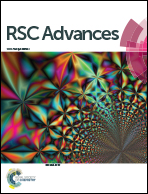β-Ga2O3 nanorod arrays with high light-to-electron conversion for solar-blind deep ultraviolet photodetection
Abstract
Vertically aligned nanorod arrays (NRAs), with effective optical coupling with the incident light and rapid electron transport for photogenerated carriers, have attracted much interest for photoelectric devices. Herein, the monoclinic β-Ga2O3 NRAs with an average diameter/length of 500 nm/1.287 μm were prepared by the hydrothermal and post-annealing method. Then a circular Ti/Au electrode was patterned on β-Ga2O3 NRAs to fabricate solar-blind deep ultraviolet photodetectors. At zero bias, the device shows a photoresponsivity (Rλ) of 10.80 mA W−1 and a photo response time of 0.38 s under 254 nm light irradiation with a light intensity of 1.2 mW cm−2, exhibiting a self-powered characteristic. This study presents a promising candidate for use in solar-blind deep ultraviolet photodetection with zero power consumption.



 Please wait while we load your content...
Please wait while we load your content...